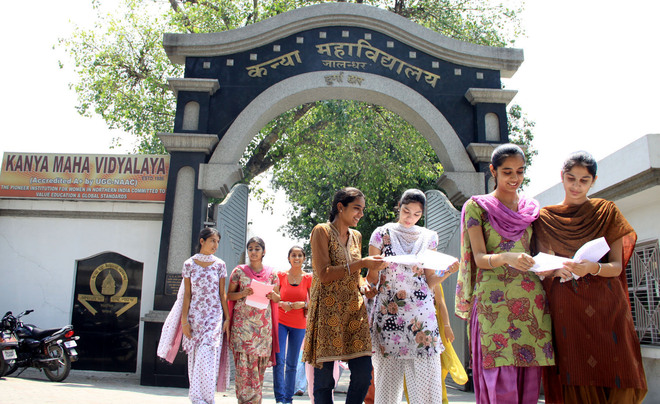
Students at Kanya Maha Vidyalaya in Jalandhar. Tribune Photo: Malkiat Singh
Aparna Banerji
Tribune News Service
Jalandhar, July 6
With the Jalandhar-based Kanya Maha Vidyalaya (KMV) making it to the list of 19 reputed institutions across the country and two in Punjab, chosen by the Centre for the grant of Special Heritage Status and consequent funding for their upkeep, it’s time for the city to celebrate.
The college has bagged Rs 80 lakh from the UGC under the programme.
Established in the year 1886 by Lala Dev Raj, KMV (then known as Bal Shiksha Vidyalaya) is among the rare surviving institutions which was at the forefront of the country’s freedom struggle. It was among the earliest women institutions of the region which was set up at a time when women venturing out of homes for education was a concept still largely looked down upon.
Lala Dev Raj established the first school exclusively for girls in Jalandhar 1886 and started Bal Shiksha Vidyalaya, with eight girls students, in 1891 and taught female pupils absolutely free. He went from home to home to exhort parents to send their daughters for education, for which he was also at the receiving end of rebukes. The Vidyalaya shifted to its present premises in 1910. The foundation stone was laid by the Maharaja of Kapurthala. Soil of Haldi Ghati was specially brought here and added to the foundation of Krishna Hall in 1932.
The Arya Samajist families in the city were one of the most benevolent patrons of the institution.
It has been served by Lala Dev Raj and his illustrious successors - Rai Bahadur Badri Dass, Savitri Devi, Shanno Devi, the legendary Archarya Lajjawati, who made it among premiere institutions of women education in North India.
The history of the college is replete with instances where students and staff participated in India’s Independence struggle and openly expressed solidarity towards the day’s leaders who put in their part in the freedom movement.
Many national leaders before and after the Independence — Lala Lajpat Rai, Dr S Radhakrishnan, Pt Madan Mohan Malviya, Pt Jawaharlal Nehru, Sarojini Naidu, Indira Gandhi, Dr Rajendra Prasad, Morarji Desai, Atal Behari Vajpayee, Inder Kumar Gujral and Dr APJ Abdul Kalam — have visited the KMV.
Role in freedom struggle
- Soon after the Jallianwala Bagh massacre in the year 1919 during the annual session of the Congress in Amritsar, students of the KMV with their rendition of the National song, dared the British government.
- In 1929, KMV girls handed over the National flag to Pt Jawaharlal Nehru during the historic National Conference on the banks of river Ravi, when the resolution of Purna Swaraj was passed.
- On a number of occasions, the KMV students helped legendary freedom fighter Bhagat Singh escape from the police. One of the KMV principals worked as defence in a court case against Bhagat Singh and his allies and also took the case to the privy council. A Svadhinta Sthal in the college still commemorates its association with the freedom struggle.
- Sushila Didi, a student, who died a martyr’s death fighting against the British rule, is etched in the pages of history of the Vidyalaya. She had been a close aide of Shaheed Chandra Shekhar Azad and Shaheed Bhagat Singh and also tied Rakhi on the wrists of these freedom fighters and put a ‘tilak’ with her own blood on their foreheads.
- A story goes that once when a bleeding Bhagat Singh came to the KMV for shelter from police, and some of his blood spilt on the gates, a student Sushila Didi cut her hands to convince the suspicious police that the blood was hers and not Bhagat Singh’s.
- When national leader Lala Lajpat Rai was in jail in Dharamsala, students of the KMV sent him a Rakhi. KMV students also held several processions against the British atrocities. Incorporating Mahatma Gandhi’s teachings in their lifestyle, the KMV girls heartily spun the Charkha, the symbol of the Swadeshi Movement.
- Despite strong British opposition, the National Flag was hoisted regularly. Often gates were closed to sing the National Anthem and National Song so that the British police posted outside did not hear students or arrest them.



























